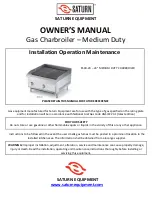
Triton
│
Installation and Operation Instructions - Maintenance
VS80-130
24
Handling Instructions
Fiberglass and Ceramic Fiber Materials -
Triton boilers use insulating materials to reduce casing losses and
clearances to combustibles. It is important for installers and service personnel to know what these materials
are, where they are located on the boiler, and how they should be handled. Refer to Table 9-1 for
recommended handling instructions and Figure 10-1 for location of insulating materials.
Insulating Materials
Specific Boiler Parts
Fiberglass Materials
Insulated Jacket Panels
Ceramic Fiber Board
Combustion Chamber (Base)
Personal Protective Equipment Recommended -
Read the following warnings and
handling instructions carefully before commencing any service work.
Fiberglass (Potential Carcinogen)
- Inhalation of airborne fibers from fiberglass
materials have been listed as a possible cause of cancer in California.
Ceramic Fiber (Potential Carcinogen)
- Use of Ceramic Fibers in high temperature
applications (above 1000
o
C) can result in the formation of Crystalline Silica
(cristobalite), a respirable silica dust. Repeated airborne exposure to crystalline silica
dust may result in chronic lung infections, acute respiratory illness, or death. Crystalline
silica is listed as a (potential) occupational carcinogen by the following regulatory
organizations:
International Agency for Research on Cancer (IARC),
Canadian Centre
for Occupational Health and Safety (CCOHS), Occupational Safety and Health
Administration (OSHA), and National Institute for Occupational Safety and Health
(NIOSH). Failure to comply with handling instructions in Table 9-1 may result in serious
injury, long term health problems, or death.
Table 9-1
Handling Instructions for Fiberglass and Ceramic Fiber Materials
Reduce the Risk of Exposure
Precautions and Recommended Personal Protective Equipment
Avoid contact with skin and eyes
Wear
long-sleeved loose fitting clothing, gloves, and safety glasses (or goggles)
.
Avoid breathing in silica dust
Wear a respirator with a N95-rated filter efficiency or better.
1
Do not dry sweep silica dust. Pre-wet or use a vacuum with a high efficiency filter.
Avoid transferring contamination
When installing or removing place the material in a sealable plastic bag.
Remove contaminated clothing after use. Store in sealable container until cleaned.
Wash contaminated
clothing separately from other laundry.
First Aid Measures
If irritation persists after implementing first aid measures consult a physician.
Skin
- Wash with luke-warm soap and water.
Eyes
- Do not rub eyes; flush with water immediately.
Inhalation
– Breathe in fresh air; drink water, sneeze or cough to clear irritated
passage ways.
Notes:
1
R
espirator recommendations based on CCOHS and OSHA requirements at the time this document was written. Consult
your local regulatory authority regarding current requirements for respirators, personal protective equipment, handling,
and disposal of RCFs.
* For more information on Fiberglass and Ceramic Fiber Materials contact CCOHS or OSHA.
Canada (CCOHS):
Telephone directory listing
under Government Blue Pages Canada—Health and
Safety—Canadian Centre for Occupational Health
and Safety; or website http://www.ccohs.ca.
United States (OSHA):
Telephone directory listing
under United States Government—Department of
Labor—Occupational Safety and Health
Administration; or website http://www.osha.gov.





































